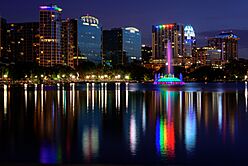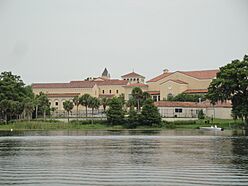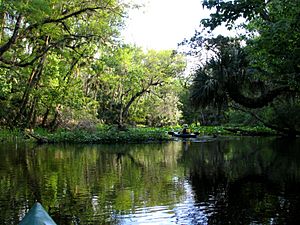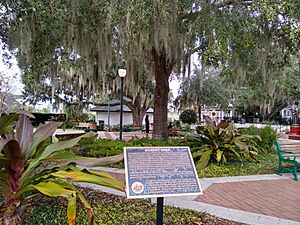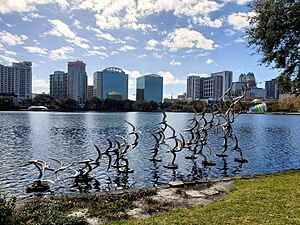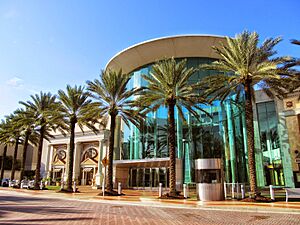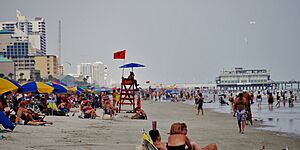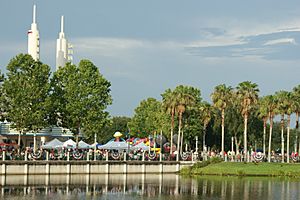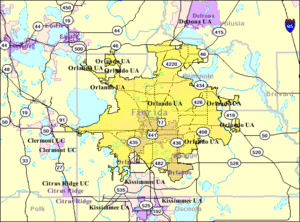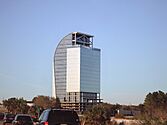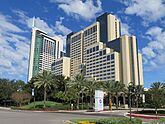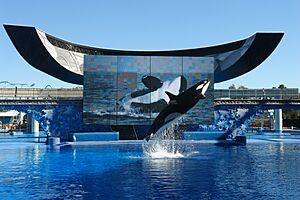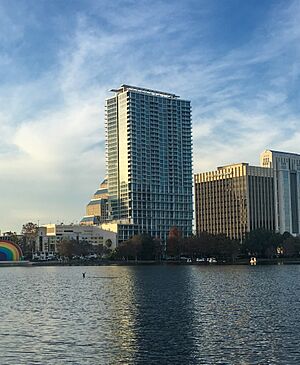Greater Orlando facts for kids
Quick facts for kids
Greater Orlando
|
|
|---|---|
| Orlando–Kissimmee–Sanford, Florida Metropolitan Statistical Area | |
|
From top (left to right): Downtown Orlando, Walt Disney World, Universal Studios Florida, Altamonte Springs, Celebration, and Rollins College
|
|
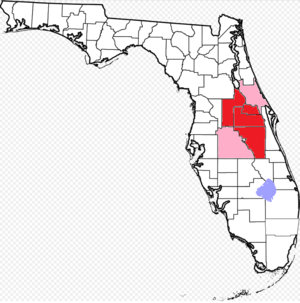
Greater Orlando with counties with many suburbs (in dark red) and counties with few suburbs (in light red)
|
|
| Country | United States |
| State(s) | Florida |
| Largest city | Orlando |
| Other cities | Kissimmee Sanford Saint Cloud Winter Garden Daytona Beach Deltona Winter Park Windermere Apopka Ocoee Casselberry Oviedo Clermont Winter Springs Altamonte Springs Lake Mary Leesburg Bay Lake Lake Buena Vista |
| Area | |
| • Total | 4,011 sq mi (10,390 km2) |
| Highest elevation | Sugarloaf Mountain 312 ft (95 m) |
| Lowest elevation | Sea level 0 ft (0 m) |
| Population
(2020)
|
|
| • Total | 2,673,376 |
| • Rank | 22nd in the U.S. |
| • Density | 666.51/sq mi (257.34/km2) |
| GDP | |
| • MSA | $194.5 billion (2022) |
The Greater Orlando area is a large urban region in the middle of Florida, a state in the United States. It's officially known as the Orlando–Kissimmee–Sanford, Florida Metropolitan Statistical Area. This means it's a big area with many cities and towns that are closely connected. The main cities here are Orlando, Kissimmee, and Sanford.
The area includes four counties: Lake, Orange (where Orlando is), Osceola, and Seminole. In 2020, over 2.6 million people lived in Greater Orlando. This makes it the third-largest metropolitan area in Florida. It's also the 22nd largest in the entire United States. The whole area covers about 4,012 square miles (10,391 km²).
Contents
Understanding Greater Orlando
The U.S. government groups areas like Greater Orlando to help understand population and economy. The Orlando–Kissimmee–Sanford area is part of an even larger group called the Orlando–Lakeland–Deltona, Florida Combined Statistical Area (CSA). This bigger area also includes places like Daytona Beach and Lakeland.
The Orlando area has grown a lot over the years.
- In 1950, it was just Orange County.
- Seminole County joined in 1959.
- Osceola County was added in 1973.
- Lake County became part of it in 1992.
The name of the area has also changed a few times to include more cities as it grew.
Weather and Nature
Orlando's Climate
Greater Orlando has a humid subtropical climate. This means it has two main seasons:
- Hot and Rainy Season: From May to late October, it's hot and humid. Temperatures often reach the low 90s °F (32–34 °C). Strong thunderstorms happen almost every afternoon. These storms can bring heavy rain and strong winds. The highest temperature ever recorded was 103 °F (39 °C) in September 1921.
- Warm and Dry Season: From November through April, the weather is more comfortable. Humidity is lower, and temperatures are cooler. Freezing temperatures are rare, happening only about 1.6 nights a year. The lowest temperature ever recorded was 18 °F (-8 °C) in December 1894. Snow is very rare, but flurries have been seen a few times.
The average yearly rainfall is about 51.45 inches (130.7 cm). Most of this rain falls during the summer months. The drier months (October to May) can sometimes lead to wildfires.
Even though Florida can get hurricanes, Orlando's location inland helps protect it. It's about 42 miles (68 km) from the Atlantic Ocean and 77 miles (124 km) from the Gulf of Mexico. However, strong hurricanes can still affect the area, as seen in 2004 when three hurricanes hit.
Cities and Towns
Largest Cities in Greater Orlando
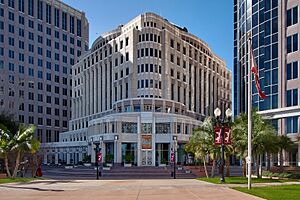
Here are some of the biggest cities in the Greater Orlando area, based on their population:
| City | County | 2020 population |
|---|---|---|
| Orlando | Orange | 307,573 |
| Deltona | Volusia | 93,692 |
| Kissimmee | Osceola | 79,286 |
| Poinciana | Osceola and Polk | 69,309 |
| Pine Hills | Orange | 66,111 |
| Sanford | Seminole | 61,051 |
| Saint Cloud | Osceola | 58,964 |
| Horizon West | Orange | 58,101 |
| Four Corners | Lake, Polk, Osceola, Orange | 56,381 |
| Apopka | Orange | 54,873 |
| Ocoee | Orange | 47,295 |
| Winter Garden | Orange | 46,964 |
| Ormond Beach | Volusia | 43,080 |
| Winter Springs | Seminole | 38,342 |
| DeLand | Volusia | 37,351 |
Main Cities
The main cities in a metropolitan area are usually the largest ones. They also have more people coming in for work than leaving. For Greater Orlando, the main cities are:
- Orlando, with a population of 307,573.
- Kissimmee, with a population of 79,226.
- Sanford, with a population of 53,570.
Other Towns and Suburbs
Greater Orlando also has many other towns and suburbs. Some are quite large, with over 10,000 people, while others are smaller. These communities help make up the diverse fabric of the metropolitan area.
Economy and Jobs
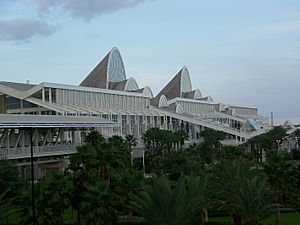
Greater Orlando is famous for its many theme parks. Places like Walt Disney World, SeaWorld Orlando, and Universal Orlando attract millions of visitors every year. Tourism is a huge part of the local economy. In 2015, about 68 million people visited the Orlando area.
In the past, growing citrus (like oranges) was very important to Orlando's economy. While it's not as big as it used to be, there are still major orange juice plants nearby. Farming, especially cattle, is still important in the outer parts of the area. Orlando is also a big center for processing food.
Since World War II, Greater Orlando has also been a key place for military defense and aerospace industries. A big company called Lockheed Martin has a lab and a factory here. The Orlando International Airport used to be a military air base!
Today, Orlando's economy is much more diverse than just tourism. It's a leading center for modeling, simulation, and training (MS&T). The University of Central Florida (UCF) is a huge university here. It has a large research park with many high-tech companies like Oracle Corporation and Siemens.
Orlando is also growing in the biotechnology and life sciences fields. A special area called Lake Nona Medical City is home to new hospitals and research centers, including a UCF College of Medicine. This area is creating many new jobs and boosting the local economy. For example, KPMG built a huge training facility in Lake Nona in 2020.
Education
In Florida, each county has its own school district. These districts are managed by an elected school board and a superintendent. The Orange County Public School District is one of the largest in the United States.
The University of Central Florida (UCF) is a very large public university in the region. It has one of the biggest student populations on campus in the U.S. UCF's main campus is in northeast Orange County.
Another well-known school is Rollins College in Winter Park. It's a private college located close to Downtown Orlando.
The Disney College Program (DCP) is a special internship program at Walt Disney World Resort in Orlando. College students (18 and older) can work at the resort for a semester or longer. They gain work experience while studying.
Other colleges and universities in the Greater Orlando area include:
- Barry University (Dwayne O. Andreas School of Law)
- Beacon College (for students with special learning needs)
- Florida A&M University College of Law
- Florida Technical College
- Full Sail University
- Johnson University Florida
- Lake–Sumter State College
- Seminole State College of Florida
- Southern Technical College
- Valencia College
Getting Around
Airports
Greater Orlando has two main airports:
- Orlando International Airport (MCO): This is the busiest airport in the area. It's a major hub for airlines like JetBlue and Southwest Airlines. JetBlue also has a training center here called JetBlue University.
- Orlando Sanford International Airport (SFB): This airport mainly handles charter flights, especially from Europe. It's also a hub for Allegiant Air.
Other airports nearby include Daytona Beach International Airport and Leesburg International Airport. These are often used by tourists visiting Daytona Beach or for pilot training.
Roads and Highways
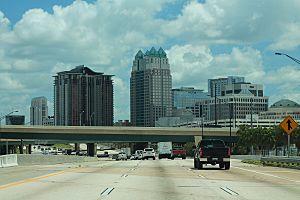
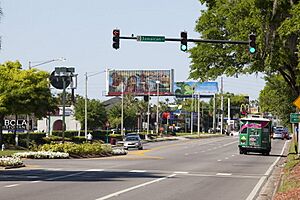
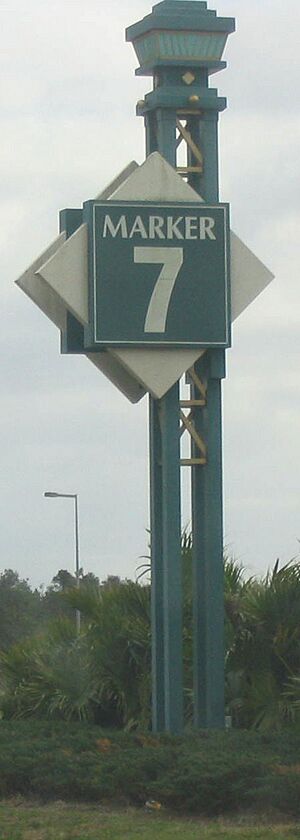
Many important highways and freeways help people get around Greater Orlando:
- Florida's Turnpike: This toll road goes southeast towards South Florida and northwest to connect with Interstate 75.
- Interstate 4: This major highway runs through Orlando. It goes north to Daytona Beach and southwest to Tampa. It's the only freeway in the area without tolls.
- Interstate 95: This highway runs along the coast, connecting areas north and south of Orlando.
- Beachline Expressway (SR 528): This road connects to the Orlando International Airport, the Space Coast, and Cape Canaveral.
- Central Florida GreeneWay (SR 417): This is a beltway that goes around the eastern part of the area, connecting both Orlando International and Orlando Sanford airports.
- East-West Expressway (SR 408): This road crosses through downtown Orlando, connecting to Interstate 4.
- Western Expressway (SR 429): This road acts as a beltway on the western side, going around Walt Disney World.
Public Transportation
Bus services in Orange, Osceola, and Seminole counties are provided by LYNX. They have many routes, including local buses and express services.

The SunRail is a commuter train system that connects Poinciana to DeBary, passing through Downtown Orlando. It started running in 2014 and expanded in 2018. There are plans to extend it to Orlando International Airport.
Amtrak trains serve several stations in the area, connecting Orlando to other major cities like New York City. The Sanford Amtrak station is special because it's the southern end of the Auto Train, which carries both people and their cars directly to Virginia.
A new high-speed train service called Brightline now connects Orlando International Airport to Miami. There are also plans to extend Brightline service to Tampa.
Culture
Orlando Chinatown
Orlando has a Chinatown located at 5060 West Colonial Drive. It's a lively area with many businesses and restaurants that celebrate Chinese, Korean, Filipino, Vietnamese, and Indian cultures.
This Chinatown used to be a shopping center. In 2003, Chinese investors helped change it into a cultural and business hub. It now has bakeries, restaurants, and Asian grocery stores, offering a wide variety of foods and goods. A special gate called a paifang was added in 2013, making the area feel even more like a true Chinatown.
Media
The main newspaper for Greater Orlando is the daily Orlando Sentinel. There are also many smaller weekly papers like Orlando Weekly and The West Orange Times.
The Orlando area is part of a large media market for TV and radio. All six major TV networks have their own channels here:
See also
 In Spanish: Gran Orlando para niños
In Spanish: Gran Orlando para niños


